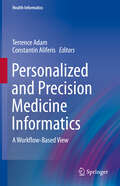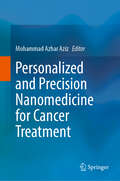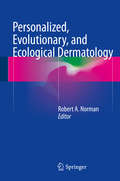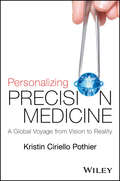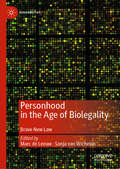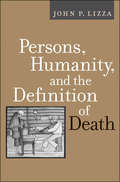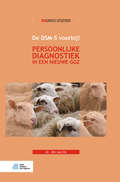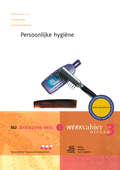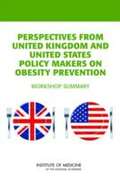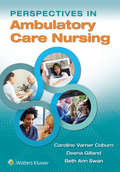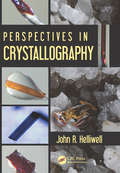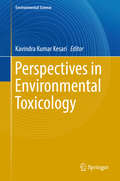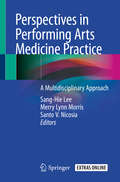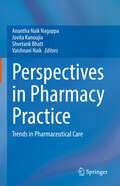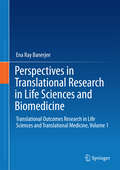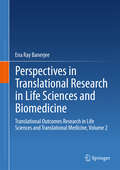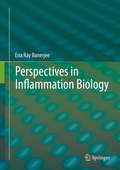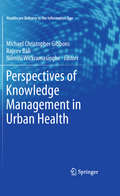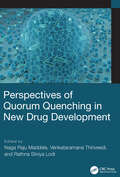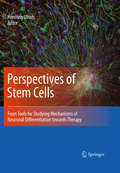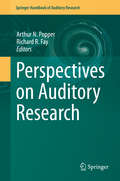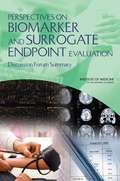- Table View
- List View
Personalized and Precision Medicine Informatics: A Workflow-Based View (Health Informatics)
by Terrence Adam Constantin AliferisThis book adopts an integrated and workflow-based treatment of the field of personalized and precision medicine (PPM). Outlined within are established, proven and mature workflows as well as emerging and highly-promising opportunities for development. Each workflow is reviewed in terms of its operation and how they are enabled by a multitude of informatics methods and infrastructures. The book goes on to describe which parts are crucial to discovery and which are essential to delivery and how each of these interface and feed into one-another.Personalized and Precision Medicine Informatics provides a comprehensive review of the integrative as well as interpretive nature of the topic and brings together a large body of literature to define the topic and ensure that this is the key reference for the topic. It is an unique contribution that is positioned to be an essential guide for both PPM experts and non-experts, and for both informatics and non-informatics professionals.
Personalized and Precision Nanomedicine for Cancer Treatment
by Mohammad Azhar AzizThis book discusses the role of nanotechnology and nanomaterials in precision and personalized medicine approaches toward cancer diagnosis, treatment, early detection, and efficient drug delivery. It also covers the applications of nanotechnology in tumor chemotherapy through increasing the specificity of anticancer agents, enhancing the killing effect of tumors, and reducing the toxic and side effects. It also discusses the significance of cancer stem cells in the diagnosis and prognosis of cancer and prospects for targeting cancer stem cells for cancer therapies by nanomaterial. Further, a chapter discusses the current status and future perspectives of actively targeted theranostics nanoparticles for tumors and associated challenges. The chapter also reviews the therapeutic role of different species of nanoparticles for enhanced radio sensitization in cancers. The subsequent chapters cover the recent advances in nanotechnology-based chemoprevention strategies for various cancers.Useful aspect of computational tools and methods in Cancer nanomedicine is discussed. This is an ideal book for students, oncologists, and researchers working in allied fields of nanotechnology, cancer, and targeted drug delivery.
Personalized, Evolutionary, and Ecological Dermatology
by Robert A. NormanThis book discusses the exciting potential for dermatology to embrace developments to enhance the profession's valuable pattern recognition, diagnostic, and treatment skills. Personalized medicine (PM) and genomics are easily accessible and enable the customization of healthcare using molecular analysis to influence medical decisions, practices, and therapies for the individual patient. The evolution of the skin, and the manner in which dermatological conditions are described and managed, reveals the need to consider many aspects on a personal level. New research data are based on the use of evolutionary medicine and genomics to highlight how we can become more successful at finding the most efficacious types of antibiotic or therapy and dosage for a particular disease or pathogen and build a competitive edge by prevention and risk management against invasive viruses, bacteria, or wrongly administered drugs. As more is understood about what grows on us and how it all interacts, along with how the introduction of new antibiotics, biologics, and other therapies affect our skin's ecological balance, this book aims to create a heightened sense of the importance and offerings of ecological dermatology.
Personalizing Precision Medicine: A Global Voyage from Vision to Reality
by Kristin Ciriello PothierThe author uses decades of experience and interviews with experts in precision medicine to explain past, present, and future of precision medicine. She reviews the full continuum of personalizing precision medicine, including diagnostics, therapeutics, big data, supportive care, regulation, and reimbursement and innovation in precision medicine worldwide.• Combines a unique cross section of history, current technologies, and future directions for how precision medicine has and will affect people worldwide• Reviews precision medicine around the world, including the US, China, Japan, the Middle East, India, Europe, and Latin America• Discusses a number of diseases areas – cancer, cardiovascular, neurodegenerative, infectious disease, pain, immunology, rare diseases• Includes information and quotes from over 100 interviews with key industry experts in biotech, pharma, informatics, diagnostics, health providers, advocacy groups, and more.• Includes stories illustrating current issues and future promises in precision medicine for a human touch
Personalmanagement im Gesundheitswesen: Instrumente wertschätzender Personalführung
by Andreas FrodlOft und gerne werden Bedeutung und Wichtigkeit der Gesundheitsberufe für die Gesellschaft betont. Häufig bleibt jedoch die tatsächlich gezeigte Wertschätzung gegenüber den Erwartungen zurück. Dies trifft nicht nur auf die üblicherweise im Vordergrund stehende, tarifvertragliche Entlohnung zu, sondern vor allen Dingen auch auf den arbeitstäglichen Umgang mit den Beschäftigten in den mehr als 200.000 Großkliniken, Krankenhäusern, MVZ, Arzt-/Zahnarztpraxen oder Pflegeeinrichtungen. Unabhängig von hierarchischen Positionen, aufbauorganisatorischen Zuordnungen oder Anstellungsverhältnissen ist der Tatsache Ausdruck zu verleihen, dass alle Angehörigen von Gesundheitsbetrieben zum Gelingen des Ganzen beitragen. Auch wenn das ärztliche Handeln dabei zwangsläufig im Vordergrund steht, so ist es letztendlich doch eine Teamleistung, die den Gesamterfolg ausmacht. Einen wesentlichen Beitrag zum Gelingen leistet ein modernes und wertschätzendes Personalmanagement, das ein breites Instrumentarium anbietet: Personalentwicklung, Mitarbeitermotivation, Personalführung, Konfliktbewältigung, Arbeitsstrukturierung, bis hin zu virtuellen Arbeitsformen. Andreas Frodl erläutert mit Hilfe von zahlreichen Beispielen die verschiedenen Methoden und Verfahren praxisnah und orientiert an den besonderen Bedürfnissen Gesundheitsunternehmen und -betrieben.In der deutlich erweiterten Neuauflage wurden zahlreiche Aktualisierungen und Ergänzungen eingearbeitet, insbesondere sei das Kapitel 5 mit der Gestaltung der Arbeitsbedingungen und -umgebungen in Gesundheitsbetrieben sowie den Digitale Arbeitswelten erwähnt. Ein Grundlagen- und Nachschlagewerk für Mediziner, Ärzte, Pflegeleitungen und Führungskräfte in Gesundheitseinrichtungen.
Personalmanagement in der Arzt- und Zahnarztpraxis von A bis Z: Erfolgserprobte Tools zum Nachschlagen und Anwenden
by Stephan Kock Kirsten KockIn der Ausbildung werden (Zahn-)Medizinerinnen und (Zahn-)Mediziner spärlich mit dem Thema Personalführung bzw. -management konfrontiert. Dieses Wissen fehlt in der täglichen Praxis und im härter werdenden Wettbewerb um die besten Köpfe. Personalmanagement ist heute mehr denn je ein erfolgsrelevanter Faktor für Arzt- und Zahnarztpraxen. In zahlreichen Beratungen und Begleitungen von Praxen wurde deutlich, dass es hieran in vielen Fällen fehlt und wie bedeutsam sich eine Veränderung auswirkt. Die Beratenen verweisen ein ums andere Mal darauf, dass es kein einfach zu nutzendes Nachschlagewerk bzw. Handbuch für ihre spezielle Situation gibt, das kurz und knapp aufklärt und Vorgehensweisen beschreibt, die sich als erfolgreich erwiesen haben. Dieser Erfolg zeigte sich sowohl in verschiedensten Gesprächs- bzw. Führungssituationen als auch bei Verträgen oder anderen Notwendigkeiten. Das Buch dient als Nachschlagewerk für Praxisinhaber¬innen und -inhaber sowie deren Führungskräfte. Es beschreibt - von A bis Z - leicht nachvollziehbar die wichtigsten bzw. am häufigsten gesuchten Begriffe rund um die Personalführung in der Arzt-und Zahnarztpraxis. Es offeriert neben den Suchbegriffen erfolgserprobte Ablaufbeschreibungen, Checklisten und Mustervorlagen.Das Buch bringt Personalmanagementwissen auf den Punkt. Einfach. Effektiv. Erfolgreich. So sparen die Verantwortlichen Zeit. Es informiert, stärkt Führungskräfte und unterstützt die Bindung von Mitarbeiterinnen und Mitarbeitern.Das Buch beschreibt 144 Fachbegriffe auf jeweils einer Seite. Bis zu 50 Graphiken, Mustervorlagen und Ablaufpläne ergänzen das Nachschlagwerk. So entstehen ca. 194 Seiten, die durch ein Interview mit einer Praxisinhaberin und ein Nachwort auf bis zu 220 Seiten aufgerundet werden.Checklisten und Mustervorlagen stehen zum Download auf SpringerLink bereit.
Personhood in the Age of Biolegality: Brave New Law (Biolegalities)
by Marc De Leeuw Sonja Van WichelenThis volume showcases emerging interdisciplinary scholarship that captures the complex ways in which biological knowledge is testing the nature and structure of legal personhood. Key questions include: What do the new biosciences do to our social, cultural, and legal conceptions of personhood? How does our legal apparatus incorporate new legitimations from the emerging biosciences into its knowledge system? And what kind of ethical, socio-political, and scientific consequences are attached to the establishment of such new legalities? The book examines these problems by looking at materialities, the posthuman, and the relational in the (un)making of legalities. Themes and topics include postgenomic research, gene editing, neuroscience, epigenetics, precision medicine, regenerative medicine, reproductive technologies, border technologies, and theoretical debates in legal theory on the relationship between persons, property, and rights.
Persons, Humanity, and the Definition of Death (Bioethics)
by John P. LizzaIn this riveting and timely work, John P. Lizza presents the first comprehensive analysis of personhood and humanity in the context of defining death. Rejecting the common assumption that human or personal death is simply a biological phenomenon for biologists or physicians to define, Lizza argues that the definition of death is also a matter for metaphysical reflection, moral choice, and cultural acceptance. Lizza maintains that defining death remains problematic because basic ontological, ethical, and cultural issues have never been adequately addressed. Advances in life-sustaining technology and organ transplantation have led to revision of the legal definition of death. It is generally accepted that death occurs when all functions of the brain have ceased. However, legal and clinical cases involving postmortem pregnancy, individuals in permanent vegetative state, those with anencephaly, and those with severe dementia challenge the neurological criteria. Is "brain death" really death? Should the neurological criteria be expanded to include individuals in permanent vegetative state, with anencephaly, and those with severe dementia? What metaphysical, ethical, and cultural considerations are relevant to answering such questions?Although Lizza accepts a pluralistic approach to the legal definition of death, he proposes a nonreductive, substantive view in which persons are understood as "constituted by" human organisms. This view, he argues, provides the best account of human nature as biological, moral, and cultural and supports a consciousness-related formulation of death. Through an analysis of legal and clinical cases and a discussion of alternative concepts of personhood, Lizza casts greater light on the underlying themes of a complex debate.
Persoonlijke diagnostiek in een nieuwe ggz: Persoonlijke diagnostiek in een nieuwe ggz
by Jim OsDit boek is een pleidooi voor persoonlijke diagnostiek. Zonder standaard vragenlijstjes, met 100 procent aandacht voor de patiënt. Persoonlijke diagnostiek gaat uit van een participerende patiënt die zijn eigen diagnostische data verzamelt en meeneemt naar de professional. Zelfrapportage dus, in het dagelijks leven en met behulp van een slimme app. Zo krijgt de behandelaar zicht op de persoonlijke ervaringsnetwerken van zijn patiënt. Dat is de eerste stap naar herstel, want in die netwerken liggen weerbaarheid én kwetsbaarheid besloten. De DSM-5 voorbij! helpt hulpverleners om de specifieke problematiek van individuele patiënten boven water te krijgen. Met het internationale classificatiesysteem DSM-5 lukt dat vaak niet, door de eenzijdige toetsing op globale criteria. Patiënten met ernstige problematiek blijven daardoor vaak in de kou staan. Binnen de huidige ggz-organisatie komen hulpverleners niet ver met persoonlijke diagnostiek. Met name regelgeving en lopende afspraken met de zorgverzekaars staan in de weg. Daarom stelt dit boek de bijdrage van DSM-5 aan het kapitalistische ‘spel’ tussen farmaceuten, psychiaters, verzekeraars en politici ter discussie. En ontvouwt Van Os tegelijk een blauwdruk voor een nieuw soort ggz.
Persoonlijke hygiëne: Basiszorg: deel 1 (Basiswerken Verpleging en Verzorging)
by Willeke Heres Ineke SteegWerkcahier incl. cd-rom Kruisinfecties en cd-rom Persoonlijke hygiëne
Perspectives from United Kingdom and United States Policy Makers on Obesity Prevention: Workshop Summary
by Institute of Medicine of the National AcademiesBoth the United Kingdom and United States are grappling with nationwide epidemics of obesity. Obesity contributes to diabetes, cardiovascular disease, and some cancers, among other diseases. Although many people are aware of obesity's causes and consequences, few see it as a problem for their own families--despite clinical evidence to the contrary. Given this disconnect between perception and reality, policy makers in both countries struggle to find a way to reach people to encourage change. The IOM brought together policy makers from the U.K. and U.S. for a workshop on October 22, 2009, to discuss the challenges of and promising approaches to the struggle against obesity. Presenters spoke about current policies, programs, and partnerships that are addressing the obesity epidemic and evidence for effective strategies to change perception and behaviors. The workshop, summarized in this document, provided an opportunity for both countries to learn from each other's efforts and to consider how to apply new strategies at home.
Perspectives in Ambulatory Care Nursing
by Beth Ann Swan Caroline Coburn Deena GillandThe perfect ambulatory care primer for undergraduate nursing students or practicing nurses transitioning from acute care settings, Perspectives in Ambulatory Care delivers expert insight into this evolving specialty and familiarizes readers with the top issues and trends they’ll encounter in ambulatory nursing practice. This authoritative resource clarifies the distinctions between ambulatory care and acute care, details the wide variety of ambulatory care roles and settings and demonstrates the growing impact and importance of nurses outside the hospital setting to help readers confidently meet the challenges of a changing healthcare landscape and succeed in this critical area of care.
Perspectives in Crystallography
by John R. HelliwellCrystallography is one of the most multidisciplinary sciences, with roots in fields as varied as mathematics, physics, chemistry, biology, materials science, computation and earth and planetary science. The structural knowledge gained from crystallography has been instrumental in acquiring new levels of understanding in numerous scientific areas. P
Perspectives in Environmental Toxicology
by Kavindra Kumar KesariThis book is a valuable contribution to the debate about the harmful effects of environmental toxicants on human health, which is a growing concern in the 21st century. Complementary chapters decipher the phenomena and highlight the latest developments in environmental toxicology, providing readers with a comprehensive overview of environmental toxicology and human health.Since the toxicants in question are not only chemical or biological in nature, but also include man-made electromagnetic fields, the book explores in detail multidisciplinary approaches to environmental toxicology, with a focus on the following five aspects: 1. The effects of man-made electromagnetic fields (RF-EMF) on human health proposed mechanisms and biological effects and measures). 2. An overview of nanotoxicity, nanomedicine and cancer research. 3. A bio-computational approach to the molecular interaction of environmental carcinogens with DNA. 4. The toxicology of environmental pollutants in the air, dust, soil, water and natural toxins in the environment: exposure and health. 5. Social insects as environmental indicators of ecotoxicological effects in different ecosystems.The book analyzes the carcinogenic, mutagenic, genotoxic and neurotoxic effects of both anthropogenic and natural toxins present in water, soil, air and our surroundings in the form of electro-pollution or electro-smog.
Perspectives in Performing Arts Medicine Practice: A Multidisciplinary Approach
by Sang-Hie Lee Merry Lynn Morris Santo V. NicosiaPerforming Arts Medicine (PAM) is a growing area of specialization within the performing arts field, which addresses the multi-faceted health and wellness of performing artists. This sub-discipline within performing arts is interdisciplinary in nature, involving the expertise of performing arts educators and researchers, physicians and other health professionals. This first of its kind text appeals to a very wide audience that includes performing arts clinical practitioners and health science researchers as well as performing arts pedagogues and performing arts students. The first part of the text gives the reader an overview of the field and discusses over-arching themes and issues in PAM. Part two presents an array of music and dance research involving primarily case studies that address significant issues of concern for performing artists and have implications for pedagogical practice. Part three provides research-based perspectives derived from professionals sharing their in-practice experiences. Finally, part four describes useful PAM models of implementation supporting the needs of performing artists in different settings. Written by experts in the field, Perspectives in Performing Arts Medicine Practice is a valuable resource for performing arts physicians, educators and researchers.
Perspectives in Pharmacy Practice: Trends in Pharmaceutical Care
by Anantha Naik Nagappa Jovita Kanoujia Shvetank Bhatt Vaishnavi NaikThis comprehensive text provides information on fundamental principles of clinical practice and how these can be implemented to provide excellent treatment to the patients. The triads of health care delivery include Physicians, Pharmacist and Nurses that have distinct roles and responsibilities of patient care. Effective pharmacy practice requires an understanding of the social context within which pharmacy is practiced, recognizing the particular needs and circumstances of the users of pharmaceutical services and of pharmacy's place within health service provision. This book presents a contemporary view of pharmacy practice research covering theories, methodologies, models and techniques that are applicable. The initial chapters describe the basics of pharmacy profession and what is the key role and responsibilities of Pharmacist in health care delivery. The central part of the book illustrates the community, hospital and ethics regarding drug formulation. The last chapters cover the therapeutic aspect of pharmacy and how these can be employed to improve patient’s health care facilities.
Perspectives in Translational Research in Life Sciences and Biomedicine
by Ena Ray BanerjeeThe present book addresses the multi-disciplinary nature of Translational Outcomes Research, which is a watershed for nearly all the disciplines of Life and Health Sciences, along with the Materials Sciences including but not limited to Zoology, Botany, Microbiology, Biochemistry, Physiology, Nanotechnology, the Medical Sciences, Bioengineering, Biophysics, Medicinal Chemistry, Structural Biology, Biostatistics and Bioinformatics. This book, for the first time, addresses the basic premises of fundamental research in facilitating drug discovery. One chapter is dedicated to a novel generation of platforms with novel camelid antibodies and their technological extensions, while another focuses on functional food and nutraceuticals. The book begins with a thorough overview of what translational outcomes research connotes and what the current status of research in the area is, and goes on to elucidate various pertinent preclinical disease models and their uses in basic and application based research in the Life Sciences. How basic approaches to screening and characterization vis-à-vis their role in amelioration of the two cardinal problems of inflammation and degeneration involved in most diseases is elucidated. The book ends with a discussion of the relevance and importance of using Bio Green technology in Translational Outcomes, addressing the need to fill the gap between academia and industry and clinics that can arise through direct or indirect collaboration between the stakeholders and emphasizing the need for an eco-friendly approach so as not to jeopardize the fine balance that holds life on earth in harmony.
Perspectives in Translational Research in Life Sciences and Biomedicine
by Ena Ray BanerjeeThe present book addresses the multi-disciplinary nature of Translational Outcomes Research, which is a watershed for nearly all the disciplines of Life and Health Sciences, along with the Materials Sciences including but not limited to Zoology, Botany, Microbiology, Biochemistry, Physiology, Nanotechnology, the Medical Sciences, Bioengineering, Biophysics, Medicinal Chemistry, Structural Biology, Biostatistics and Bioinformatics. This book, for the first time, addresses the basic premises of fundamental research in facilitating drug discovery. One chapter is dedicated to a novel generation of platforms with novel camelid antibodies and their technological extensions, while another focuses on functional food and nutraceuticals. The book begins with a thorough overview of what translational outcomes research connotes and what the current status of research in the area is, and goes on to elucidate various pertinent preclinical disease models and their uses in basic and application based research in the Life Sciences. How basic approaches to screening and characterization vis-#65533;-vis their role in amelioration of the two cardinal problems of inflammation and degeneration involved in most diseases is elucidated. The book ends with a discussion of the relevance and importance of using Bio Green technology in Translational Outcomes, addressing the need to fill the gap between academia and industry and clinics that can arise through direct or indirect collaboration between the stakeholders and emphasizing the need for an eco-friendly approach so as not to jeopardize the fine balance that holds life on earth in harmony.
Perspectives in inflammation biology
by Ena Ray Banerjee"Perspectives in Inflammation Biology" outlines detailed studies using preclinical murine models in Inflammation. The book is meant for academicians, industry persons, research scholars and students alike. The detailed perspective for a beginner and the exhaustive methodologies and analyses outlined, for the veteran researcher, makes this book a unique link between someone who is thinking of embarking on a study of inflammation and one who is delving deep into this area of specialization. The book deals with asthma and allergy as specific disease areas of inflammation of the lung, aseptic peritonitis as a disease of systemic inflammation and details how each role player in its pathophysiology has a unique niche of activity. Data acquisition, sequentiality and analyses in context demonstrate how each role player is validated systematically to become a target for drug discovery. Methods and models used in the course of my work and their relevance will demonstrate to the researcher how a study can be developed from an idea. Further into a researcher's ongoing work, this book is meant to stimulate new questions and pave ways for better dissection of a phenomenon. The highlights of this book are the detailed tables tabulating sub species of immune cells, their inflammatory recruitment indices, their translation into tissue-to-tissue traffic of the inflammatory stimulus and the delicate interplay of resident structural cells, cells recruited from circulation, their feedback poiesis in bone marrow, their instruction in the lymphoid organs and tissues as well as the non-cellular mediators synthesized from corresponding genetic instruction. The book shall definitely help students and researchers how a disease can be simplified from its complex ramifications and network of implications and put back into perspective and the whole thing falls into place without an intimate understanding of the mechanism and the compelling circumstances that causes a disease, a drug hunter cannot hope to begin her quest. To find the "Achilles' heel" and effectively neutralize the enemy!
Perspectives of Knowledge Management in Urban Health
by Nilmini Wickramasinghe Michael Christopher Gibbons Rajeev BaliIt is a tragic paradox of American health care: a system renowned for world-class doctors, the latest medical technologies, and miraculous treatments has shocking inadequacies when it comes to the health of the urban poor. Urban Health Knowledge Management outlines bold, workable strategies for addressing this disparity and eliminating the "knowledge islands" that so often disrupt effective service delivery. The book offers a wide-reaching global framework for organizational competence leading to improved care quality and outcomes for traditionally underserved clients in diverse, challenging settings. Its contributors understand the issues fluently, imparting both macro and micro concepts of KM with clear rationales and real-world examples as they: * Analyze key aspects of KM and explains their applicability to urban health. * Introduce the KM tools and technologies most relevant to health care delivery. * Offer evidence of the role of KM in improving clinical efficacy and executive decision-making. * Provide extended case examples of KM-based programs used in Washington, D.C. (child health), South Africa (HIV/AIDS), and Australia (health inequities). * Apply KM principles to urban health needs in developing countries. * Discuss new approaches to managing, evaluating, and improving delivery systems in the book's "Measures and Metrics" section. Urban health professionals, as well as health care executives and administrators, will find Urban Health Knowledge Management a significant resource for bringing service delivery up to speed at a time of great advancement and change.
Perspectives of Quorum Quenching in New Drug Development
by Naga Raju Maddela, Venkataramana Thiriveedi, Rathna Silviya LodiAntibiotic resistance in pathogen microorganisms is a major global concern, especially the formation of biofilms. Quorum quenching has been practically used to control biofilm growth, and this indicates a promising hope for the development of new drugs for the control of biofilm-forming pathogens. This book provides a single source of information about two issues: the biology of quorum sensing and quorum quenching, and the perspectives of quorum quenching in new drug development. The text covers the latest literature from the last ten years and insights into quorum quenching and its need in medicine as an anti-virulence strategy.Features: Exclusively focuses on quorum quenching and its ability to be used as an alternative to antibiotics in the control of multidrug-resistant pathogens. Reviews the latest literature and case studies of the last ten years in the field of quorum sensing and quorum quenching. Promotes a new approach to the development of the next generation of antibacterial drugs. In the wake of rising antibiotic drug resistance, it is crucial to develop an alternative approach to control bacterial infection diseases and quorum quenching appears to be a promising strategy in the development of new medicines.
Perspectives of Stem Cells
by Henning UlrichThe field of stem cell biology is geared towards translation into clinical practice through in vitro tissue production and regeneration therapy. Since the discovery of adult neurogenesis, much attention has been put on the study of differentiation of stem cells into neural cell types and the development of model systems for stroke and neurodegenerative diseases. In addition to chapters on therapeutic applicability of embryonic, very small-embryonic like, mesenchymal stem and neural progenitor cells, this book covers signalling mechanisms guiding induction to differentiation and cell diversification. Furthermore, fundamental aspects of stem cell biology and neurogenesis, such as the importance of proliferation induction, programmed cell death and the function of glia in differentiation of stem cells and development of neuronal circuits, are also highlighted. In vitro cultures of embryonic, mesenchymal and neural stem cells as well as mobilization of endogenous stem and precursor cells for brain repair and replacement therapy in neurological disorders are important issues of this book. Each chapter is written by researchers who are leaders in the field and provides an invaluable resource for information on the most current advances in the field and possible therapeutic applications, with discussions of controversial issues and areas of emerging importance. By providing an up-to-date and critical view of the state of Science, we hope that this book shall be a base for exciting scientific ideas regarding functions and therapeutic applications of stem cells in the adult brain. The book is directed to neuroscientists, physicians, students and all who are engaged and interested in the exciting and rapidly expanding field of modern neuroscience and stem cell biology.
Perspectives on Auditory Research
by Arthur N. Popper Richard R. FayPerspectives on Auditory Research celebrates the last two decades of the Springer Handbook in Auditory Research. Contributions from the leading experts in the field examine the progress made in auditory research over the past twenty years, as well as the major questions for the future.
Perspectives on Biomarker and Surrogate Endpoint Evaluation: Discussion Forum Summary
by Institute of Medicine of the National AcademiesIn 2010 the Institute of Medicine (IOM) recommended a framework for the evaluation of biomarkers in the chronic disease setting. Published in the book Evaluation of Biomarkers and Surrogate Endpoints in Chronic Disease, the framework is intended to bring consistency and transparency to the previously disparate process of biomarker evaluation. Following the book's release, the IOM convened a 2-day discussion forum in Washington, DC, in order to provide an opportunity for stakeholders to learn about, react to, and discuss the book. Presentations reviewed the authoring committee's work process, recommendations, and provided perspectives on the book from the point of view of participants. Thomas Fleming, professor of biostatistics and statistics at the University of Washington, gave a keynote presentation on the critical issues in the validation of surrogate endpoints, a specific use of a biomarker. The present volume recounts the discussion forum proceedings, focusing in turn on each represented sector. A summary of Dr. Fleming's presentation then sets the committee's recommendations within the context of biomarker utilization. Lastly, this summary examines the main themes raised by stakeholders, and the challenges and opportunities presented to stakeholders by the book's recommendations.
Perspectives on Cancer Care
by Anne McQueen Josephine Tonks N FawcettPerspectives on Cancer Care is a unique collection of insights from contributors, based on their specific expertise and experience. It provides a range of perspectives on cancer care to inspire readers and encourage high-quality care through an enhanced understanding of patients' needs and carers' skills. The book presents a series of chapters highlighting different circumstances and approaches to the complex reality of cancer care. In each chapter the author presents their own picture of their experience of the individual's needs and the care required to address these needs, illustrating the particular sensitivity, trust, empathy and support required in the care of patients with cancer and their families. The holistic approach to total care is a prominent feature in cancer care and this is illustrated throughout the various chapters. This collection of perspectives on cancer care: highlights particular issues in the field encourages best practice draws on the expertise of specialist practitioners in the field of cancer care features a holistic approach to cancer care, illustrated through scenarios
